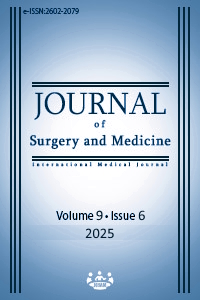From hashtags to healing: Social media insights on kinesio taping in Türkiye
Social media insights on kinesio taping
Keywords:
Kinesio taping, Social media, HealthcareAbstract
Background/Aim: Social media provides valuable insights into healthcare practices, including kinesio taping (KT), a technique used for pain relief and stability. Despite its popularity, there is limited research on KT content on social media. This study aims to analyze social media posts related to KT in Türkiye.
Methods: The study was conducted by analyzing posts on social media platforms including Twitter, Instagram, Facebook, and YouTube. The hashtags ‘#kinezyobant’, ‘#kinezyobantlama’, and ‘#kinezyoteyp’, as well as the keywords ‘kinezyobant’, ‘kinezyobantlama’, and ‘kinezyoteyp’ were used as search criteria. The collected data were categorized into different groups: healthcare organizations, commercial entities, physicians, news sources, users, and non-physician healthcare professionals.
Results: A total of 445 posts related to KT were identified across various social media platforms. YouTube boasted the highest number of posts, followed by Twitter, Facebook, and Instagram. Non-physician healthcare professionals contributed the most posts, whereas physicians and news sources posted relatively less. Twitter saw the highest number of user-generated posts, while Instagram displayed a higher prevalence of posts for commercial purposes. Among all platforms, Facebook accounted for the highest number of posts by healthcare organizations.
Conclusion: Social media platforms, especially YouTube, are crucial in disseminating information about KT. Non-physician healthcare professionals notably contribute to the online discourse, potentially highlighting the need for enhanced KT education among physicians. Facebook offers benefits for patients to communicate with and engage in healthcare organizations. However, addressing concerns about misinformation and privacy, along with promoting responsible usage of these platforms in healthcare, is crucial.
Downloads
References
Dwivedi YK, Ismagilova E, Hughes DL, et al. Setting the future of digital and social media marketing research: Perspectives and research propositions. International Journal of Information Management. 2021;59:102168. DOI: https://doi.org/10.1016/j.ijinfomgt.2020.102168
Laranjo L, Arguel A, Neves AL, et al. The influence of social networking sites on health behavior change: a systematic review and meta-analysis. J Am Med Inform Assoc. 2015, 22:243-256. doi: 10.1136/amiajnl-2014-002841 DOI: https://doi.org/10.1136/amiajnl-2014-002841
Courtney K, Shabestari O, Kuo AM-H. The use of social media in healthcare: organizational, clinical, and patient perspectives. Enabling health and healthcare through ICT: available, tailored and closer. 2013;183:244.
Morris D, Jones D, Ryan H, Ryan CG. The clinical effects of Kinesio® Tex taping: A systematic review. Physiother Theory Pract. 2013;29:259-70. doi: 10.3109/09593985.2012.731675 DOI: https://doi.org/10.3109/09593985.2012.731675
Ünlü Özkan F, Soylu Boy FN, Erdem Kılıç S, et al. Clinical and radiological outcomes of kinesiotaping in patients with chronic neck pain: A double-blinded, randomized, placebo-controlled study. Turk J Phys Med Rehabil. 2020;66:459-67. doi: 10.5606/tftrd.2020.5632 DOI: https://doi.org/10.5606/tftrd.2020.5632
Erden Y, Temel, M.H., Bagcier, F. Türkiye’de Kuru İğneleme Tedavisi: Instagram Bize Ne Fısıldıyor? 2023.
Prochaska JJ, Coughlin SS, Lyons EJ. Social media and mobile technology for cancer prevention and treatment. American Society of Clinical Oncology Educational Book. 2017:128-37. doi: 10.1200/EDBK_173841 DOI: https://doi.org/10.1200/EDBK_173841
Taggart T, Grewe ME, Conserve DF, Gliwa C, Roman Isler M. Social media and HIV: A systematic review of uses of social media in HIV communication. J Med Internet Res. 2015;17:e248. doi: 10.2196/jmir.4387 DOI: https://doi.org/10.2196/jmir.4387
Bagcier F, Yurdakul OV, Temel MH. Quality and readability of online information on myofascial pain syndrome. J Bodyw Mov Ther. 2021;25:61-6. doi: 10.1016/j.jbmt.2020.11.001 DOI: https://doi.org/10.1016/j.jbmt.2020.11.001
Pizzuti AG, Patel K, McCreary EK, et al. Healthcare practitioners’ views of social media as an educational resource. PLoS ONE. 2020;15. DOI: https://doi.org/10.1371/journal.pone.0228372
Cordos AA, Bolboacă SD, Drugan C. Social media usage for patients and healthcare consumers: A literature review. Publ. 2017;5:9. DOI: https://doi.org/10.3390/publications5020009
Gage-Bouchard EA, LaValley SA, Mollica MA, Beaupin LK. Communication and exchange of specialized health-related support among people with experiential similarity on Facebook. Health Communication. 2017;32:1233-40. DOI: https://doi.org/10.1080/10410236.2016.1196518
Mukherjee SK, Kumar J, Jha AK, Rani J. Role of social media promotion of prescription drugs on patient belief-system and behaviour. Int J e Collab. 2019;15:23-43. DOI: https://doi.org/10.4018/IJeC.2019040102
Shepherd A, Sanders C, Doyle M, Shaw J. Using social media for support and feedback by mental health service users: thematic analysis of a Twitter conversation. BMC Psychiatry. 2015;15. DOI: https://doi.org/10.1186/s12888-015-0408-y
Robillard JM, Whiteley L, Johnson TW, Lim JS, Wasserman WW, Illes J. Utilizing social media to study information-seeking and ethical issues in gene therapy. Journal of Medical Internet Research. 2013;15. DOI: https://doi.org/10.2196/jmir.2313
Om A, Ijeoma B, Kebede S, Losken A. Analyzing the quality of aesthetic surgery procedure videos on TikTok. Aesthetic surgery journal. 2021. DOI: https://doi.org/10.1093/asj/sjab291
Swan K. Exploring the Role of Video in Enhancing Learning from Hypermedia. Journal of Educational Technology Systems. 1996;25:179-88. DOI: https://doi.org/10.2190/C2NL-15N8-83R9-4UWR
Basch CH, Hillyer GC, Garcia P, Basch C. Content of widely viewed YouTube videos about celiac disease. Public health. 2019, 167:147-51. DOI: https://doi.org/10.1016/j.puhe.2018.11.004
van de Wiel MWJ, Van den Bossche P, Janssen S, Jossberger H. Exploring deliberate practice in medicine: how do physicians learn in the workplace? Advances in Health Sciences Education. 2010;16:81-95. DOI: https://doi.org/10.1007/s10459-010-9246-3
Yıldırım Y, Parlar S, Eyigor S, et al. An analysis of nursing and medical students’ attitudes towards and knowledge of complementary and alternative medicine (CAM). Journal of Clinical Nursing. 2010;19(7-8):1157-66. DOI: https://doi.org/10.1111/j.1365-2702.2009.03188.x
Muindi B. Negotiating the balance between speed and credibility in deploying Twitter as journalistic tool at the Daily Nation Newspaper in Kenya. African Journalism Studies. 2018;39:111-28. DOI: https://doi.org/10.1080/23743670.2018.1445654
Silva CV, Jayasinghe D, Janda M. What can Twitter tell us about skin cancer communication and prevention on social media? Dermatology. 2020;236:81-9. DOI: https://doi.org/10.1159/000506458
Alassani R, Göretz J. Product Placements by Micro and Macro Influencers on Instagram. In Interacción. 2019. DOI: https://doi.org/10.1007/978-3-030-21905-5_20
Karimova GZ. Exploring visual framing strategies, sentiment, and product presentation modality in instagram posts of fashion influencers. 2020. DOI: https://doi.org/10.29107/rr2020.1.6
Day S, Hughes A. P102 A highly cost-effective and targeted service promotion campaign using the social media site Facebook. Sexually Transmitted Infections. 2012;88:A44. DOI: https://doi.org/10.1136/sextrans-2012-050601c.102
Househ MS. The use of social media in healthcare: Organizational, clinical, and patient perspectives. Studies in health technology and informatics. 2013;183:244-8.
Downloads
- 296 316
Published
Issue
Section
How to Cite
License
Copyright (c) 2025 Mustafa Hüseyin Temel, Fatih Bağcıer
This work is licensed under a Creative Commons Attribution-NonCommercial-NoDerivatives 4.0 International License.
















